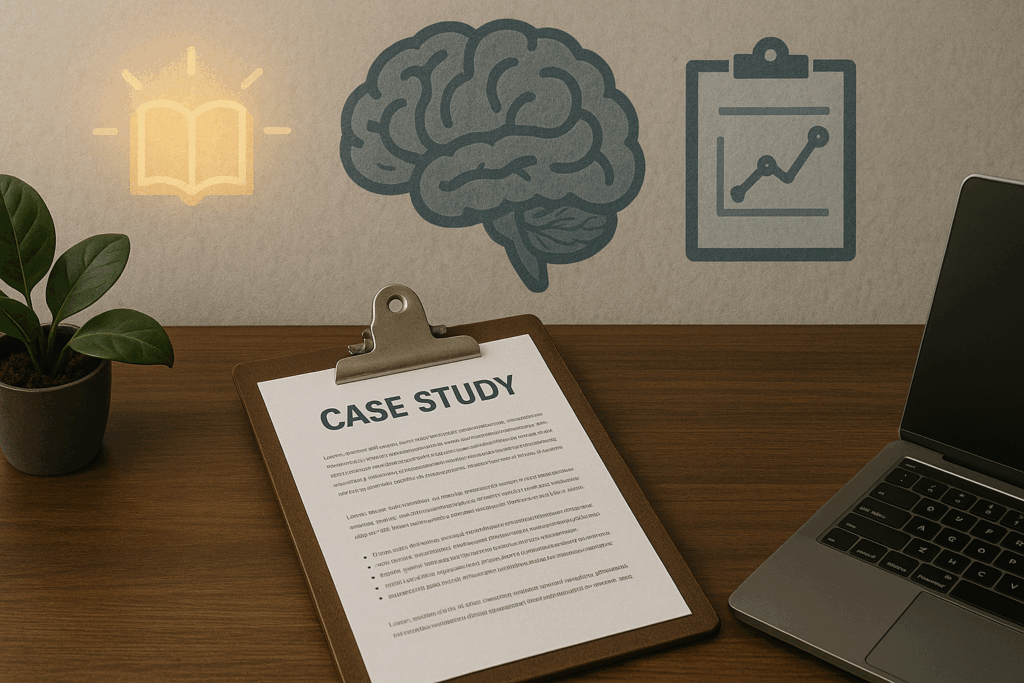Case studies are often treated like formal proof—a tidy document filled with data, timelines, and quotes. But if you want your case studies to actually move someone, to shift perception and inspire action, then you need more than just evidence. You need a story.
Why? Because stories activate the brain in ways facts alone never can.
When structured well, case studies become one of your most powerful sales tools—not just because they show results, but because they engage attention, stir emotion, and build trust through a narrative that the brain is wired to remember.
Let’s explore how to structure your case studies based on the neuroscience of storytelling—so they do more than inform. They convert.
The Neuroscience of Storytelling
When someone reads or hears a story, their brain lights up in synchrony with the storyteller’s. This is known as neural coupling. Stories activate not only the language centers of the brain but also the sensory, emotional, and motor cortices, making the experience more immersive and memorable.
Here’s what’s happening under the hood:
- Oxytocin release: Stories that feature struggle, empathy, or triumph stimulate the release of oxytocin—a neurochemical linked to trust and connection.
- Dopamine spikes: A compelling arc or moment of resolution activates the brain’s reward system, reinforcing memory.
- Mirror neurons: These fire when we observe others’ actions or emotions, helping us relate to the characters in a story—even if it’s a business customer in another industry.
When your case studies follow a narrative structure, you’re not just showcasing your product—you’re transporting your prospect into the buyer’s journey. And that creates influence.
The Problem with Traditional Case Studies
Most case studies fall flat because they read like this:
Client X implemented Product Y. After three months, they increased revenue by 17%. The client was pleased with the results.
While technically true, this format lacks emotional tension, human detail, and storytelling flow. It triggers only the analytical brain, not the emotional or sensory centers that lead to action.
To fix that, you need to shift from a reporting mindset to a narrative mindset.
The 5-Part Brain-Friendly Case Study Structure
Use this neuroscience-backed story arc to structure your case studies:
1. The Protagonist (Make It Personal)
Start with a specific character your audience can relate to—a sales director, a marketing manager, an HR leader—not just “Company X.”
“When Lauren, Director of Sales at GrowthTech, took over the East Coast region, her team was missing quota five quarters in a row.”
✅ Brain benefit: Personal names and roles activate mirror neurons and invite empathy.
2. The Conflict (Create Tension)
Introduce the core challenge or pain point. This is your opportunity to show stakes—not just logistical problems, but emotional and professional ones.
“Despite trying two different CRMs, Lauren’s reps were disengaged, and she was under pressure to fix the numbers before year-end.”
✅ Brain benefit: The amygdala (threat detection) tunes into tension, making the story more memorable.
3. The Journey (Highlight the Turning Point)
Describe how your product or service entered the picture—but avoid making your brand the hero. Instead, focus on how the customer took action and changed their trajectory with your support.
“Lauren’s team began using our sales enablement platform. What changed first wasn’t the numbers—it was behavior. Reps started logging activity consistently, coaching conversations deepened, and for the first time, the team felt aligned.”
✅ Brain benefit: Dopamine is released during forward motion and progress, reinforcing engagement.
4. The Resolution (Quantify + Humanize Results)
Now it’s time to share results. Go beyond numbers—add color to the win.
“In just 10 weeks, the region hit 112% of quota. But what Lauren valued most? Her reps finally believed they could win again.”
✅ Brain benefit: Combining data and emotion activates both the logical and emotional networks, improving recall and resonance.
5. The Takeaway (Connect to the Reader’s World)
End by tying it back to the audience. Invite them to see themselves in the story.
“If you’re leading a team that’s struggling to turn things around, Lauren’s story proves it’s possible—with the right tools and the right support.”
✅ Brain benefit: The default mode network, which helps with perspective-taking and imagining the future, encourages action when a story feels relevant.
Formatting Tips to Boost Neural Engagement
- Use subheads and white space. The brain processes content faster when it’s visually digestible.
- Include headshots and job titles. Seeing a real face boosts oxytocin and trust.
- Break up text with pull quotes or stats. These act as visual anchors and support memory encoding.
- Use conversational language. Avoid jargon and write like you’re telling a story over coffee.
The ROI of Story-Driven Case Studies
Feature | Brain Reaction | Business Outcome |
Named protagonist | Mirror neurons activated | Higher relatability |
Conflict and emotional stakes | Amygdala engagement | Improved recall |
Concrete resolution | Dopamine release + logic integration | Stronger conversion intent |
Future-focused takeaway | Default mode network activation | Buyer envisions themselves in the story |
When case studies are built like stories, they stop being passive proof and start becoming persuasive tools that guide the buyer’s brain through a memorable, emotionally resonant arc—one that ends with belief in your product.
Final Thought
The brain doesn’t remember bullet points. It remembers stories.
So if you’re still writing case studies like dry recaps, you’re leaving trust, attention, and conversions on the table. Instead, tell a story that the brain will latch onto—and let your past customers become the proof and the persuasion.
Because in the end, the best case study doesn’t say,
“Here’s what we did.”
It says:
“Here’s what someone just like you achieved—and how.”





